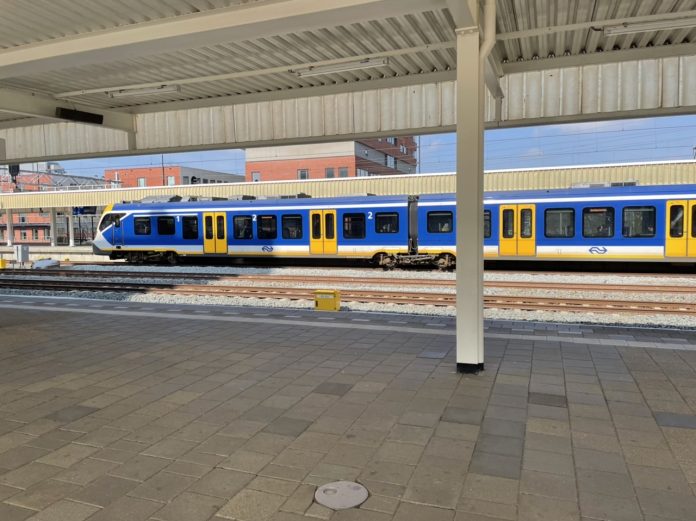Puget Sound is investing heavily in large transit expansion projects like light rail and bus rapid transit. These are critically important for moving people quickly over in-city and short regional distances on-demand. But as the region grows around transit, policymakers need to begin planning how to transport people over longer distances rapidly. That means picking the right transit typology for this task. Enter regional rail.
So far, the region has made strides toward a foundation for regional rail with two Sounder commuter lines, but service is infrequent, peak-oriented, and weekday-only. The southern line is the most successful of the two due to station area catchments, level of service, and relative topographic soundness. But both lines can and should become the backbone of a larger frequent regional rail network.
Why Link isn’t sufficient for regional trips
Now, there is a belief among many that Link is supposed to be the spine for regional rapid transit. But it’s not.
Light rail is a flexible technology best suited for short-range and mid-range trips in urban areas, not regional ones. Trying to make it the rapid regional transit typology is asking it to do far too much and it will fail on its own.
Consider the travel time from Downtown Seattle to Seattle-Tacoma International Airport: a typical trip takes 38 minutes to traverse 15 miles. From Northgate, the trip to the airport takes 53 minutes to go 23 miles. Those aren’t terrible travel times, but from Potsdam near Berlin to Berlin Hauptbahnhof takes a mere 24 minutes on DB Regio regional rail, going a distance of about 20 miles.
When Link finally reaches Tacoma in the early 2030s, the typical travel time to Downtown Seattle (a distance of about 36 miles) will be 74 minutes. Between Everett and Tacoma (a distance of about 66 miles), a trip would be 131 minutes when the Everett Link extension opens in the late 2030s or early 2040s. That, of course, doesn’t factor in the gamble of service disruptions in Rainier Valley on the 1 Line’s at-grade segment (though we could lessen that if we wanted to). These aren’t travel times that indicate a region really accessible by transit and competitive with driving outside peak hours.
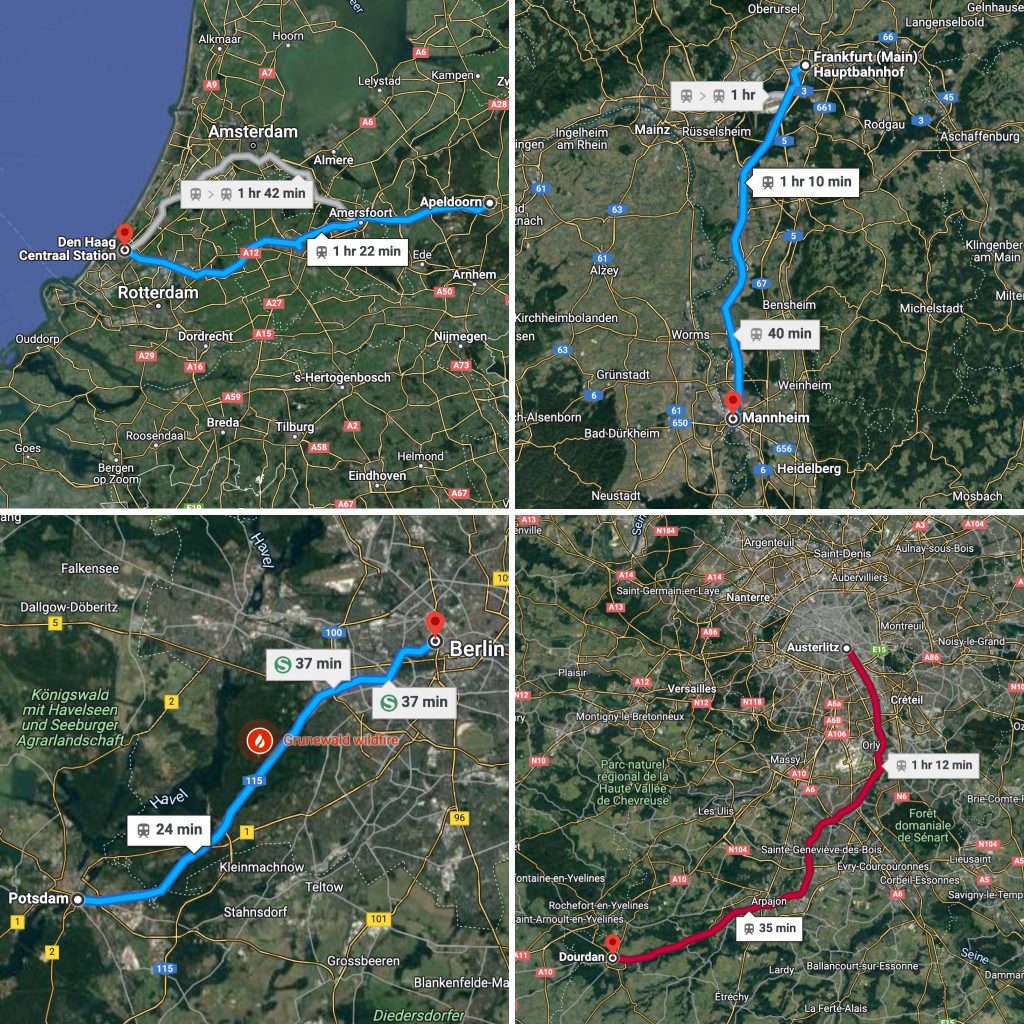
Travel times in urban regions abroad are much better over long distances and usually competitive with driving outside peak hours.
In Paris, one can travel from outer suburbs like Dourdan to central Paris (Gare d’Austerlitz) in just 45 minutes across 35 miles. In Frankfurt, one can travel from cities like Mannheim (51 miles away) in 70 minutes. And in the Randstad, one can travel from Apeldoorn to Den Haag Centraal (a distance of 80 miles) in 82 minutes. Plenty of smaller communities are directly served by local stops, too, bringing them into the rapid transit fold.
A regional rail spine is a fit for Puget Sound
Puget Sound has a very long, linear urban geography. This makes it uniquely suited to be served by regional rail service, including branches to other locales. In the past, The Urbanist has suggested several approaches to expanding conventional passenger rail services to places like Marysville, Olympia, and even Maple Valley. Indeed, these are extensions and spurs worthy of consideration, but before addressing those in detail, it’s important to explain what regional rail is.
Regional rail is designed to provide train service between cities and towns within a cohesive region. The frequency of stops is higher than intercity passenger rail across a shorter distance, but often has fewer stops and faster service than commuter rail. Typically, service is provided consistently throughout the day, runs in both directions, and operates all days of the week.
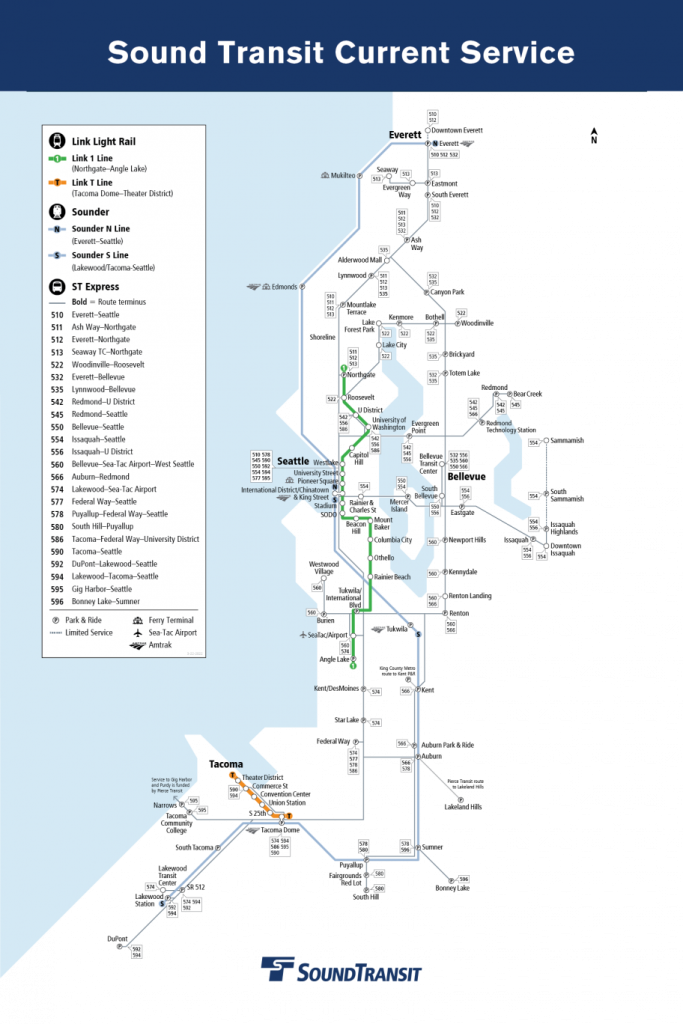
This stands in stark contrast to Puget Sound’s commuter rail and limited intercity passenger rail system. Right now, Sound Transit only operates two Sounder services — mostly in the peak direction — along BNSF tracks stretching from Lakewood to Everrett via Tacoma and Seattle. Just 13 stations exist along that corridor with service ranging from two to 13 weekday trips, depending upon the segment. Amtrak also offers a minimal number of daily trips to an even smaller number of stations. This isn’t the paragon of good passenger rail service, but it is the start of a good idea. Sound Transit is slowly restoring service and eventually plans make targeted capacity enhancements to its southern Sounder line, including an extension to DuPont. Amtrak and the state have visions of nearly hourly intercity passenger rail service between Seattle and Portland.
But if Sounder were ever to reach true regional rail service levels, it would be quite transformative for people wanting to get across the region and make transit an obvious travel choice, even for those deeper in the suburbs and rural areas.
Initial phase of Puget Sound regional rail
So what might regional rail look like in Puget Sound?
For starters, we could launch a three-line system between Olympia and Stanwood with some trains through-running in Seattle from Everett to Tacoma. We could run these trains throughout the day every day of the week as follows:
| Line | Corridor | Service Pattern |
| R1 | Everett-Tacoma | Trains twice hourly serving only major stations |
| R2 | Olympia-King Street Station | Trains twice hourly serving all stations |
| R3 | Stanwood-King Street Station | Trains twice hourly serving all stations |
This service pattern could provide for an effective 15-minute service for all major stations from Everett to Tacoma and 30-minute service for all other stations in the system.
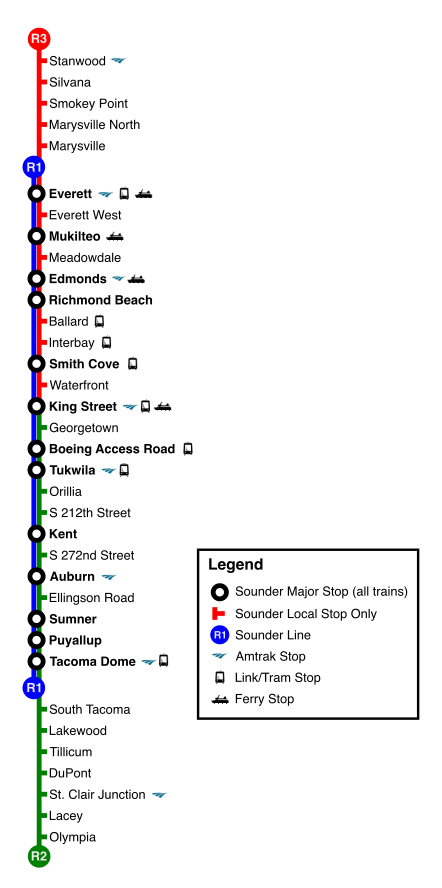
If Amtrak Cascades service ever builds up to the 13 daily trips that the state rail plan envisions, the effective frequency on the corridor could be a bit higher with Sound Transit partnering to greatly expand the Rail Plus program. Doing so would allow riders to hop onto near-hourly Cascades trains within the regional rail area and reach stations served by Cascades, which would be a bit faster than baseline regional rail express service. Currently, Cascades stops at Stanwood, Everett, Edmonds, King Street Station (Seattle), Tukwila, and Tacoma Dome Station, but conceivably it could also stop at St. Clair Junction and Auburn to allow ideal rail-to-rail transfers if the regional rail plan were realized.
Second phase of Puget Sound regional rail
As part of a larger regional rail network, Sound Transit could embark on targeted expansions into the suburbs, such as southeast of Tacoma, Southeast King County, and the Eastside. This could be a much more elaborate system that similarly relies on overlaying branch lines to provide frequency in common corridors and logical transfer points.
A total of eight lines could traverse the region, allowing people to have one-seat rides where they’re unheard of today, such as Stanwood to Renton, Auburn to Snohomish, and Enumclaw to Olympia. These aren’t exactly in-demand transit connections today, but that’s in part because such connections don’t even exist. But more importantly, it’s the destinations in between that are likely to prove more useful as everyday connections. That’s the power of regional rail though: untransited areas can become transited ones.
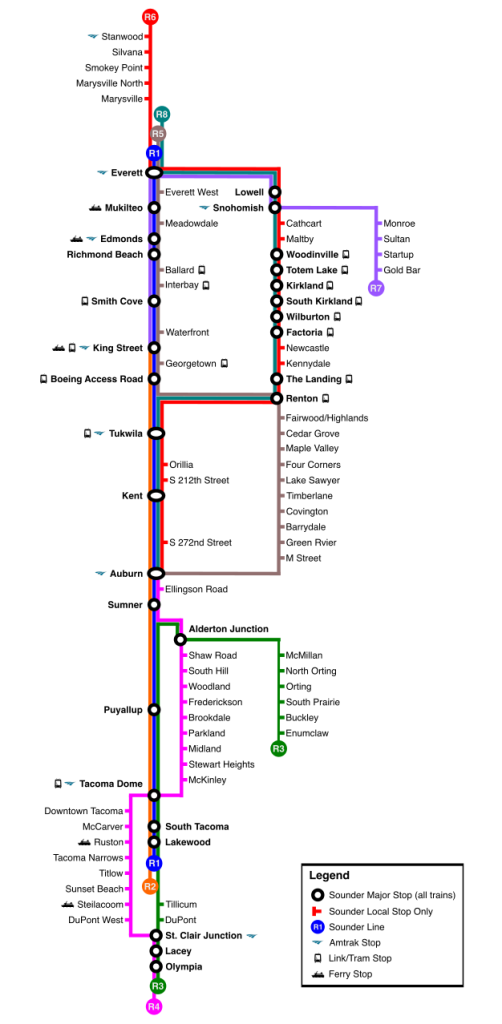
So let’s tick through the eight lines and their service patterns:
| Line | Corridor | Service Pattern |
| R1 | Everett-Lakewood | Trains twice hourly serving only major stations |
| R2 | Lakewood-King Street Station | Trains four times hourly serving only major stations |
| R3 | Olympia-Enumclaw via Sumner and Lakewood | Trains twice hourly serving all stations |
| R4 | Olympia-Auburn via Point Defiance and Frederickson | Trains twice hourly serving all stations |
| R5 | Auburn-Everett via Renton and King Street Station | Trains twice hourly serving all stations |
| R6 | Auburn-Stanwood via Renton and Everett | Trains twice hourly serving all stations |
| R7 | King Street Station-Gold Bar via Everett | Trains twice hourly serving all major stations as well as all stations between Monroe and Gold Bar |
| R8 | Everett-Auburn via Snohomish and Renton | Trains twice hourly serving only major stations |
This would ensure that all portions of the network have service at least every 30 minutes and many segments would effectively have service at least every 15 minutes. Service could also be strategically designed to support logical transfers at key connection points using a clock-face, timed-transfer scheduling approach.
Additionally, notable Link connections could be overlaid on the Eastside with shared service on some sections where Link alignments are elevated above the regional rail tracks. Seattle Subway has some interesting ideas for this area, but it could be improved with more infill stations to allow for better local service on Link — which is really the point of light rail — while Sounder regional rail does the work for longer-distance travel on common corridors.
In addition to this phase, it would be wise to consider how regional rail might integrate with Cascadia high-speed rail if and when such a corridor is built out and creating new conventional rail corridors entirely, possibly modeled on Perth’s highway-based approach to regional rail.
What it would take
Implementing this regional rail initiative in one or both forms would certainly be a big project and require deep cooperation between the Washington State Department of Transportation, freight rail companies, and local governments. It would also likely mean expanding the Sound Transit taxing district or at least allowing other areas to opt-in to benefit from the effort and service (barring more direct state support).
In terms of major tasks to realize regional rail, Sound Transit would need to:
- Procure new train equipment (preferably diesel multiple units or some form of electric multiple units);
- Build simple infill stations, largely without parking (though some at further out stations may be useful);
- Construct additional mainline, passing, and siding tracks in coordination with freight rail companies;
- Rebuild some tracks sympathetically with existing trails (such as near Olympia);
- Negotiate with freight rail companies for additional track use rights;
- Completely stabilize and mitigate the cliffs along Puget Sound to prevent landslide incursions onto tracks;
- Improve signaling and train management systems; and
- Take other actions to increase speeds on tracks and improve reliability.
Negotiating with freight rail companies might be a challenge, but track use is nowhere near capacity and offering to improve the central corridor may be a big help in getting freight rail companies to play ball. Lucrative contracts for service operations may also prove a useful carrot, but the state legislature certainly could help grease the wheels, too, with defensible sticks that aren’t in conflict with federal law.
To be successful, both regional rail concepts require density and complementary transit connections. Local jurisdictions need to plan for housing and active destinations around stations. This is especially important because a notable number of stations would be situated near bodies of water, reducing their walkshed/bikeshed, but density at any station, of course, is a natural good for ridership. Frequent, connecting transit at all stations is necessary, too. Fortunately many potential locations already have local bus, ferry, and Link/tram connections, but growing these in the years ahead will be vitally important in building up potential demand and land use naturally oriented toward regional rail.
Summing it all up
Ultimately, staying on the current path of “light rail is our destiny and future” will ring fairly hollow in the decades that lie ahead as people come to realize it alone is insufficient for regional transit. We have a chance to build a comprehensive world-class transit system that moves people quickly across the region, reaches deep into communities, and centers people’s lives around it for everyday travel. A regional rail system can help feed our local transit networks and even help build up widespread intercity demand for transit. In the process of this, we can also reorient many of our suburban communities as car-light places. Planning needs to begin on a regional rail system now so that it can form the next package of regional transit expansion investments.
You can view a full interactive map of the proposed regional rail system on Google Maps.
Stephen is a professional urban planner in Puget Sound with a passion for sustainable, livable, and diverse cities. He is especially interested in how policies, regulations, and programs can promote positive outcomes for communities. With stints in great cities like Bellingham and Cork, Stephen currently lives in Seattle. He primarily covers land use and transportation issues and has been with The Urbanist since 2014.

